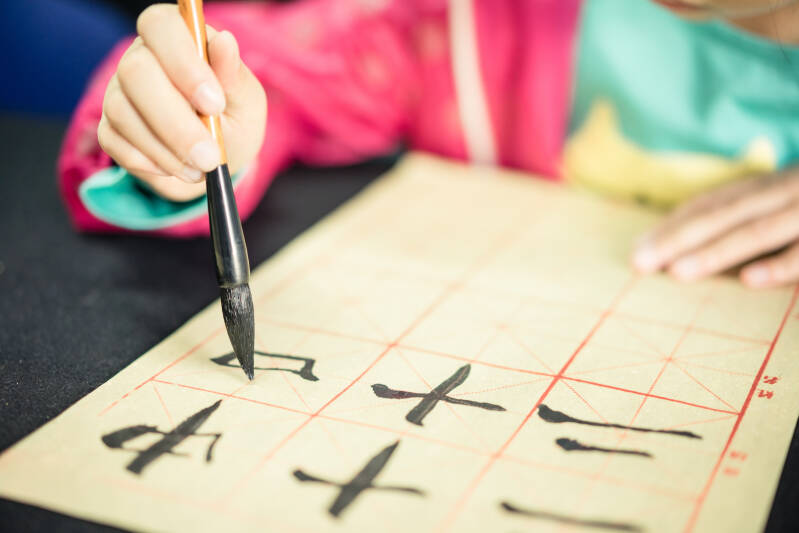by Ariel Cevallos
The International Student Street Fair at Ohio University brought together a vibrant display of cultures from around the world. The lively array of student organizations from around the globe showcased their culinary delights, offering an inviting journey through diverse cuisines. From the savory momo dumplings of Nepal to the refreshing mango lassi from India and the fragrant Vietnamese spring rolls, attendees were treated to a rich culinary experience. Amidst this diverse feast, the Chinese Language Student Association took a unique approach, opting not to offer traditional food but instead creating an immersive cultural experience. Their stand invited attendees to delve into the rich heritage of China through a variety of interactive crafting activities. From the delicate art of papercutting to the intricate designs of Beijing Opera masks, visitors had the opportunity to refine their skills and explore the traditions of Chinese craftsmanship. Additionally, they could try their hand at calligraphy, mastering the graceful strokes of Chinese characters, or create their own paper lamps, adding a touch of artistic charm to the fair. Through these hands-on activities, participants not only engaged in creative expression but also got a glimpse into the fascinating traditions that have shaped Chinese culture over the centuries.

The history of Chinese lanterns traces back to the Eastern Han dynasty, around 25 to 220 AD, where paper lanterns were first recorded. Originally crafted from bamboo or wood frames covered in silk or paper, these lanterns featured traditional designs and were used for festivities and religious ceremonies. During the Tang dynasty (618 to 907 AD), lanterns became immensely popular, symbolizing prosperity and peace as citizens released them into the sky. This tradition evolved into the modern-day Lantern Festival, celebrated on the 15th day of the Chinese calendar, marking the end of Chinese New Year festivities. Families gather to light and admire lanterns, often decorated with riddles for entertainment. Chinese lanterns carry symbolic meanings, with red symbolizing wealth and prosperity, yellow representing luck and neutrality, and green symbolizing health and harmony. Participants were given the opportunity to craft their own, adding a personal touch to this timeless tradition.

Before paper's invention, ancient Chinese artisans turned to precious metals such as silver and gold to craft intricate designs. Credited to Cai Lun in AD 105, paper initially remained a luxury reserved for the elite due to its complex production process. However, as its availability increased, papercuts emerged as vital components of Chinese daily life, adorning various objects with symbolic designs. Papercuts reflected Chinese cultural symbols and beliefs, from marital bliss to prayers for luck and protection against evil forces. They also entertained through shadow plays, where paper figures were manipulated to cast shadows on screens. During China's revolutionary period, papercuts reflected political ideologies, featuring imagery glorifying leaders like Chairman Mao. However, in the twenty-first century, papercuts have returned to their traditional artistic and decorative roles, with some artists incorporating foreign influences and modern themes. During the street fair, attendees were provided with colorful paper and guided through the process of creating intricate patterns, resulting in delightful shapes to adorn their surroundings.


Peking Opera, a celebrated Chinese art form, integrates traditional facial painting to delineate characters' traits and roles. The colors and patterns of the facial makeup convey specific attributes, such as courage, villainy, or obstinacy. These masks embody significant figures from Chinese history and fiction, each encapsulating a unique narrative and cultural significance. The craft of fashioning these masks originated in Beijing during the Song dynasty, with each brushstroke transforming plaster into a vivid portrayal of a Peking Opera character. Attendees were encouraged to adorn their own masks, drawing inspiration from a collection of designs showcased in a book.
In Chinese culture, calligraphy holds a special place as a revered art form. Its roots trace back to ancient times, but it really flourished during the Han dynasty. Calligraphy isn't just about writing—it's about creating beautiful artwork with words. Using special brushes and ink, calligraphers craft letters and symbols that are like a window into their personality. It's not just about what's written; it's also about expressing emotions and thoughts. Even in today's modern China, calligraphy remains popular, with artists continuing to explore its rich tradition. Attendees practiced writing Chinese characters on mats using water, allowing them to refine their skills without fear of making mistakes. A variety of brushes were provided, enabling participants to experience the fluidity and grace of this ancient art form.
The event, coinciding with Moms Weekend, attracted a diverse crowd, ranging from young children to mature individuals. Despite the occasional breezes, the warm sunshine provided the perfect backdrop for a day of cultural exchange. Participants reveled in the opportunity to immerse themselves in the beauty and intricacies of Chinese culture, fostering a deeper understanding and appreciation within the Ohio University community.



Add comment
Comments